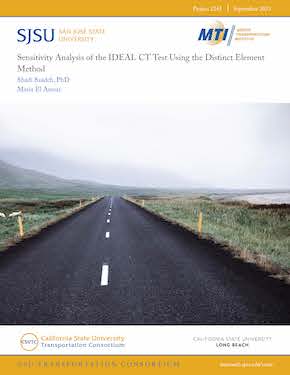- 408-924-7560
- mineta-institute@sjsu.edu
- Donate
Sensitivity Analysis of the IDEAL CT Test Using the Distinct Element Method
Cracking is a primary mode of failure for asphalt concrete (AC), resulting in road damage and deterioration, and leading to an increase in road hazards and fatalities. Studying the fracture behavior of AC is an effective way to learn how to best enhance their cracking resistance. To do this, the indirect tensile cracking laboratory test (IDEAL-CT) was developed and used to assess the AC cracking behavior by defining a unique index that allows the ranking of different mixes’ cracking resistance. The sensitivity of the test results to the test parameters is needed to monitor the test’s performance. Several parameters impact the result of the IDEAL-CT. This study focuses on the variation of air voids, loading rate, aggregate shape, bonding type, and gradation mix. Performing more than 450 test scenarios—varying multiple factors and conducting enough tests for each variation—would require considerable resources and time. To solve the issue, the Particle Flow Code in two-dimension software (PFC2D) using the discrete element method (DEM) is adapted to mitigate the need for actual laboratory tests. Initial findings yielded a better understanding of the micromechanical behavior of each mix, showing that air void content has more impact than loading rate; a decrease of 2% in air voids resulted in an increase of more than 50% in cracking resistance. Additionally, different aggregate sources and bonding strengths affected the cracking resistance. These results can inform further studies on AC cracking in order to reduce road damage and deterioration to keep roads safe.
SHADI SAADEH, PHD
Dr. Saadeh is a professor at California State University, Long Beach. He holds a Bachelor’s Degree in Civil Engineering from the University of Jordan, a Master’s Degree in Civil Engineering from Washington State University, and a PhD in Civil Engineering from Texas A&M University.
MARIA EL ASMAR
Maria is currently a student of Master’s in Civil Engineering at California State University, Long Beach. She holds a Bachelor’s degree in Civil Engineering from Lebanese University Faculty of Engineering-II, Lebanon. Her research focuses on pavement material.
-
Contact Us
San José State University One Washington Square, San Jose, CA 95192 Phone: 408-924-7560 Email: mineta-institute@sjsu.edu






